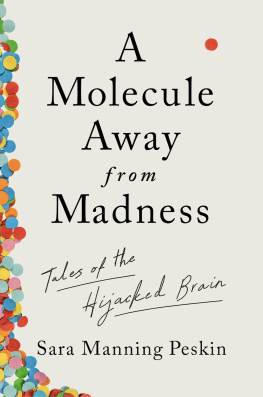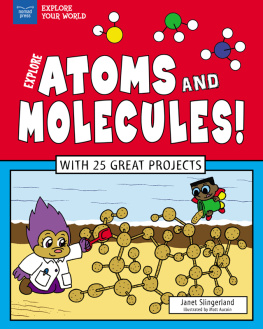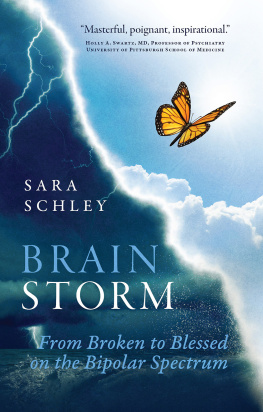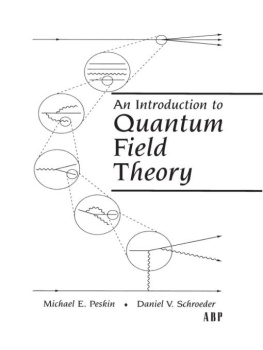Contents
Page-list
Guide

A MOLECULE AWAY FROM MADNESS
Tales of the Hijacked Brain

Sara Manning Peskin

A Molecule Away from Madness is a work of nonfiction. The names of patients and family members have been changed.
Copyright 2022 by Sara Manning Peskin
All rights reserved
First Edition
For information about permission to reproduce selections from this book, write to Permissions, W. W. Norton & Company, Inc., 500 Fifth Avenue, New York, NY 10110
For information about special discounts for bulk purchases, please contact W. W. Norton Special Sales at specialsales@wwnorton.com or 800-233-4830
Jacket design: Pete Garceau
Jacket image: venakr / iStock Photo
Book design by Lovedog Studio
Production manager: Lauren Abbate
Library of Congress Cataloging-in-Publication Data
Names: Peskin, Sara Manning, author.
Title: A molecule away from madness : tales of the hijacked brain / Sara Manning Peskin.
Description: First edition. | New York, NY : W. W. Norton & Company, [2022] | Includes bibliographical references and index.
Identifiers: LCCN 2021041595 | ISBN 9781324002376 (hardcover) | ISBN 9781324002383 (epub)
Subjects: LCSH: Neurosciences. | BrainResearch.
Classification: LCC RC327 .P47 2022 | DDC 612.8/2dc23/eng/20211004
LC record available at https://lccn.loc.gov/2021041595
W. W. Norton & Company, Inc., 500 Fifth Avenue, New York, N.Y. 10110
www.wwnorton.com
W. W. Norton & Company Ltd., 15 Carlisle Street, London W1D 3BS
For Jeremy, who taught me to tell a story, and for JJ and Oliver, our captive audience
CONTENTS
A MOLECULE AWAY FROM MADNESS
AT YOUR BEGINNING, A TADPOLE-SHAPED CELL found the opaque edges of a human egg and burrowed inside. The fertilized eggnow an embryocinched itself and divided into two. Two cells became four, four became eight, and so on until something astounding happened: instead of remaining identical, each cell took on a different role.
Some cells were shipped off to the frontier to become skin. Others began manufacturing hormones that could make you sleepy, hungry, or nervous. Still others became muscle cells that could manipulate the bones in your growing skeleton.
The organ that defines your personalitythe one that makes you, youstarted off in the embryo as a sheet of cells roughly the size of a pencil tip. Over just a few days in early development, the sheet rolled up into the shape of a long tube. One end of the structure stretched to form your spinal cord, while the other blossomed into the very brain you are using to read this page today.
Just above your eyes, you developed neurons that help you control impulses. Neurons on the sides of your brain learned to interpret language and music. Toward the top of your head, neurons became specialists in arithmetic and judgment. Underneath, a set of neurons sorted out visual information couriered from the back of your eyeballs.
Voil. You became the owner of the most complex machine known to humankind. Your brain has more than eighty-six billion neuronsmore than the brain of any other animal on earth. It is larger in size than the brain of any other primate, and it holds more data than the most cutting-edge smartphone. Parts of our brains are so complex that they do not even develop fully until we reach our mid-twenties.
And yet.
Our brains have an Achilles heel. The very molecules that make our brains work can also co-opt our personalities and destroy our ability to think. Our temperament, memories, and relationship to reality can all be lost to molecules that are billions of times smaller than our brains. Tales of guerrilla warfare have fascinated humans for millennia, but few of us realize that our brains are engaged every day in the same genre of conflict. We are forever surviving on the brink, battling molecules that can destroy our minds.
Molecule is a daunting word that turns out to have a simple meaning: a molecule is a group of atoms bound together. You are probably already familiar with atoms, like oxygen, carbon, and hydrogen. When atoms are linked together, we call the resulting structure a molecule.
Water is a molecule that contains two hydrogen atoms and one oxygen atom and is thus called H2O. Thiamineanother molecule that will become important in this bookis also made of hydrogen and oxygen atoms, but it contains carbon and nitrogen atoms, too. Deoxyribonucleic acid (DNA) is an enormous, stringy molecule built from the same atoms as thiamine, with the addition of phosphorus.
All these molecules are so small that you cannot see them with traditional microscopes. A cup of water contains a septillion water moleculesmore than a trillion times the world population. A grain of sand contains more molecules than there are insects on the earth. Even DNA, the largest molecule in the human body, is so small that scientists can directly visualize its structure only with a specialized microscopeand they just discovered how to do this in 2012.
But the size of molecules says nothing about their ability to co-opt the mind. This book is about molecular villains, millions of times smaller than the brain yet so nimble in hijacking its function. Scientists have written volumes about each of these molecules, but I like to think of them more casually as mutants , rebels , invaders , and evaders .
Mutants are altered sequences of DNA. If you consider DNA as a giant three-dimensional computer code, mutants are like small typos that cause the program to self-destruct. As you will see in the first chapters of this book, mutants can inflict deadly cognitive maladies on generation after generationa sentence we are now close to commuting thanks to some of the most striking discoveries in all of neurology.
Rebels are aberrant proteins. Under normal circumstances, proteins are wildly talented molecules that carry out the directions given by our DNA. If we return to the idea of DNA as a computer code, proteins are the people and infrastructure that bring the code to life, like the conductors who operate trains according to the timetable dictated by an algorithm. But proteins can also rebel against us, taking aim at our brains and inflicting a rapid and dramatic destruction. Recalcitrant proteins can cause us to hallucinate, to erupt in anger, and to descend into a trembling dementiaall phenomena you will get to know well in the second part of this book.
Finally, there are so-called small molecules, much tinier than DNA and proteins, that can invade our brains when they are unwelcome, or be absent when we need them to be present. Returning to the locomotive analogy, you can think of small molecules either as obstacles that block the train tracks (invaders) or as fuel required for the train to move in the first place (evaders). As you will discover in the final chapters of this book, these tiny invaders and evaders can throw us into rapturous rages, turn us into constant liars, and instill an insidious, striking state of confusion.
The characters and conundrums that occupy the upcoming pages are not simply the stuff of scientific oddity. The stories in this book represent the foundation for the most exciting frontier in cognitive neurology today. By examining the molecules that hijack the brain, we can start to understand how we will treat Alzheimers disease and other common brain diseases in the future.














